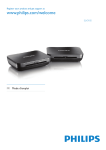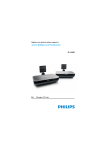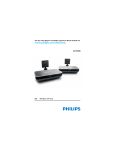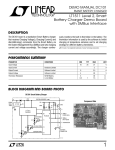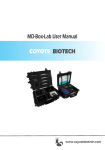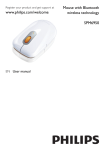Download Philips Wireless TV link SLV3105
Transcript
Register your product and get support at
www.philips.com/welcome
SLV3105
EN User manual
Eng l i s h
Table of contents
Important
1
1.1 Power requirements
1.2 Conformity
1.3 Recycling and disposal
1.4 Electric, Magnetic and Electromagnetic
Fields ("EMF")
1.5 Installation requirements
4
4
4
5
2
Your Wireless TV link
2.1 What's in the box
2.2 Overview of the Wireless TV link
7
7
7
5
6
3
3.1
3.2
3.3
3.4
3.5
Getting started
Connect transmitter
Connect receiver
Enjoy
Install the remote control blaster cord
Remove interference on TV2
9
9
10
10
11
11
4
Technical data
12
5
Frequently asked questions
13
6
INDEX
16
7
Declaration of Conformity
17
Table of contents
EN
3 3
1
Important
Take time to read this user manual
before you use your wireless TV link.
It contains important information and
notes regarding your wireless TV link.
1.1
Power requirements
Connect the power adapters only to a
100-240V AC 50/60Hz power supply.
The Electrical network is classified as
hazardous. The only way to power
down the charger is to unplug the
power supply from the electrical
outlet. Ensure that the electrical
outlet is always easily accessible.
Warning
To avoid damage or malfunction:
Do not expose the wireless TV link to
excessive heat caused by heating
equipment or direct sunlight.
Do not drop your wireless TV link or
allow objects to fall on your wireless
TV link.
Do not use any cleaning agents
containing alcohol, ammonia, benzene,
or abrasives as these may harm the
set.
Do not use the product in places
where there are explosive hazards.
Do not let small metal objects come
into contact with the product. This
can deteriorate audio quality and
damage the product.
Active mobile phones in the vicinity
may cause interference.
Do not open your product as you
could be exposed to high voltages.
Do not allow the charger to come
into contact with liquids.
Do not allow the TV link to come
into contact with liquids.
4 4 EN
Use only with provided power supply.
Concord.
Philips
Manufacturer:
SSW1918
Model Name: CM-3AD09005.
Power supply information for receiver
and transmitter.
AC100-240V/300mA,
Input: AC100-240V/120mA,
50Hz/60Hz
50Hz/60Hz
Output: DC9V/500mA
DC9V/1100mA
About operating and storage
temperatures:
Operate in a place where
temperature is always between 0 and
40oC (32 to 103oF).
Store in a place where temperature is
o
-10 and
and 60°C
70 C (14
always between -25
(-13to
o
and 140°F).
157
F).
1.2
Conformity
This product has been designed, tested
and manufactured according the
European R&TTE directive 1999/5/EC
Following this directive, this product can
be brought into service in the following
states:
0682
R&TTE Directive 1999/5/EC
Class identifier. This is a class 1 product.
We, Philips, declare that the product is
in compliance with the essential
requirements and other relevant
provisions of Directive 1999/5/EC. You
can find the Declaration of Conformity
on www.p4c.philips.com.
Important
The WEEE directive (Waste Electrical
and Electronic Equipment; 2002/96/EC)
has been put in place to ensure that
products are recycled using best available
treatment, recovery and recycling
techniques to ensure human health and
high environmental protection.
Your product is designed and
manufactured with high quality materials
and components, which can be recycled
and reused.
1.4
1.
2.
Do not dispose of your old product in
your general household waste bin.
Inform yourself about the local
separate collection system for
electrical and electronic
products marked by this
symbol:
Use one of the following disposal options:
1. Dispose of the complete product
(including its cables, plugs and
accessories) in the designated
WEEE collection facilities.
2. If you purchase a replacement
product, hand your complete old
product back to the retailer. He
should accept it as required by the
WEEE directive.
Packaging information:
Philips has marked the packaging with
standard symbols designed to promote
the recycling and appropriate disposal of
your eventual waste.
A financial contribution has been
paid to the associated national
recovery & recycling system.
The labeled packaging material is
recyclable.
Important
3.
4.
5.
Electric, Magnetic and
Electromagnetic Fields
("EMF")
En g l i s h
1.3
Recycling and disposal
Disposal instructions for old products.
Philips Royal Electronics
Manufactures and sells many
consumer oriented products
which usually, as with any
electronic apparatus, have the
ability to emit and receive
electro magnetic signals.
One of Philips' leading Business
Principles is to take all necessary
health and safety precautions for
our products, to comply with all
applicable legal requirements and
to stay well within the EMF
standards applicable at the time
of producing the products.
Philips is committed to develop,
produce and market products
that cause no adverse health
effects.
Philips confirms that if its
products are handled properly
for their intended use, they are
safe to use according to scientific
evidence available today.
Philips plays an active role in the
development of international
EMF and safety standards,
enabling Philips to anticipate
further developments in
standardisation for early
Integration in its products.
EN
5 5
1.5
Installation requirements
The product transmits and receives
radio waves when it is switched on.
The product complies with the
standards that are defined for it.
As the product is based on RF
technology, the quality of the image
can be influenced by microwave
ovens, Bluetooth, Wifi etc.
Therefore the product can suffer
from the same kinds of interference
as GSMs, portable radios and other
RF-based products.
6
6 EN
Important
Your Wireless TV link
Eng l i s h
2
Congratulations on your purchase and welcome to Philips!
To fully benefit from the support that Philips offers, register your product
at www.philips.com/welcome.
2.1
What's in the box
2.2
Overview of the Wireless TV link
Transmitter
Control and display elements
1
2
3
4
Your Wireless TV link
5
6
1 Power light:
> green: on
2 On/off switch
3 Power input connector (DC 9V)
4 Remote control blaster cord port
5 SCART cable
6 Wireless channel selection switch
> Find the CHANNEL switch on
4 available channels
EN
7 7
Receiver
Control and display elements
7
Power light:
> green: on
8 On/off switch
9 Power input connector (DC 9V)
10 SCART cable
11 Wireless channel selection switch
> Find the CHANNEL switch on
4 available channels
7
8
9
10
11
Remote control blaster cord
12
8
8 EN
13
12 Connector
13 Blaster light
Your Wireless TV link
Getting started
3.1
Connect transmitter
1. Connect the video source to the
transmitter
a. Take the supplied transmitter (A).
Find the SCART cable that is
connecting the video source to the
TV1. Disconnect this SCART cable.
Eng l i s h
3
c. The green LED on the front panel
should be on.
Note: the video source can be a
satellite receiver, a VCR, a DVD
player or recorder...
Video source
Transmitter
Note: if it is not the case, press the
ON/OFF switch on the back of the
product.
2. Connect TV1
Plug the SCART cable from TV1 into
the SCART connector of the
transmitter (A).
Transmitter
Transmitter
Video source
TV1
3. Connect the power adapter
a. Take the supplied power
adapter (C) to plug the connector
into the DC 9V power connector
on the transmitter (A).
b. Plug the adapter into the power
outlet.
Getting started
4. Check that TV1 is working well
a. Switch on TV1
b. Check that TV1 is working well.
c. Switch on the connected video
source.
d. Check if TV1 shows the image of
the video source.
> The transmitter is connected
correctly.
5. Connect the remote control blaster
cord (D) to the IR socket.
Please reference to "3.4 Install the
remote control blaster cord" to
have more information.
EN
9 9
3.2
Connect receiver
Preparation
- Switch on the transmitter (A).
c. The green LED on the front panel
should be on.
- Switch on the Video source.
- Take these items:
Receiver (B)
Power adapter (C)
Remote control of the video
source.
- Go to TV2.
Note: if it is not the case, press the
ON/OFF switch on the back of the
product.
1. Connect the receiver to the second
TV (TV2)
Plug the SCART cable of the receiver
(B) into the SCART port of TV2.
3. Set the CHANNEL switch to the
same number that on the
transmitter (A).
TV2
2. Connect the power adapter
a. Take the supplied power
adapter (C) to plug the connector
into the DC 9V power connector
on the Receiver (B).
b. Plug the adapter into the power
outlet.
10 10EN
3.3
Enjoy
All the operations listed on 3.1
and 3.2 should have been done.
1. Switch on TV2.
2. Switch on the receiver (B).
3. Select the correct SCART input on
TV2.
4. Point the remote control of the video
source to the receiver (B).
5. Operate the video source with its
remote control.
6. Check if TV2 shows the image of the
video source.
> The receiver is connected correctly.
Getting started
TV2
Note: If the VCR or DVD recorder
records a television program, you watch
the recorded channel.
Note: how to watch a video source on
TV1?
Use your TV1 and your video source as
usual to watch a video source on TV1.
3.4
Install the remote control
blaster cord
3.5
Remove interference on TV2
When 3.1 and 3.2 are done, you may
have some interferences.
1 Find the CHANNEL switch on the
transmitter (A). There are 4 channels.
You may have to change the channels
in case of interferences.
2 Set the CHANNEL switch to a
different number on the
transmitter (A) in case of
interferences.
The remote control blaster cord
transmits IR signal to Source devices.
1 Switch off the transmitter (A).
2 Connect the remote control blaster
cord (D) to the IR socket.
3 Position the blaster light in front of
the video source. Just put it in front
of the IR sensor on the front panel.
3 Find the CHANNEL switch on the
receiver (B).
4 Set the CHANNEL switch to the
same number as on the
transmitter (A).
Note: See the user manual of the video
source for the exact location of the IR
sensor on the front panel.
Getting started
EN11 11
Eng l i s h
4 Switch on the transmitter (A).
5 If the IR control blaster is well
installed, you can use your remote
control to manage your video source.
4
Technical data
Transmitter
System: RF (TV-LINK)
Modulation: FM
Weight: 0.292kg
Dimensions:120X182X40.2mm
Carrier Frequency: 2400~2470MHz
Channels: 4
Radiated Output Power: 10mW
Effective Transmission Range: 40m
Audio Input level: 2V
Video Input level: 1.1V
Power requirements: 9V/500mA
IR Extender Receiver
RF Frequency: 433.92MHz
Receiving Sensitivity: -90 ~ -98 dBm
IR carrier Frequency: 30~57kHz
IR LED Operation Range:
3m
Audio frequency response: 40Hz~15kHz
Power Requirements: 9V/500mA
IR Extender Transmitter
IR Frequency: 433.92MHz
RF Output Power: 7~9dBm
IR carrier Frequency: 30~57kHz
IR Sensor Operation Range:
7m
Temperature range
o
Operation: Between 0 and 40 C
o
(32 to 103 F ).
Storage: Between -10 and 70oC
o
(14 to 157 F).
Relative humidity
Operation: Up to 90% at 40oC
Storage: Up to 90% at 40oC
Receiver
System: RF (TV-LINK)
Weight: 0.290kg
Dimensions:120X182X40.2mm
Playback frequency range: 2400~2470MHz
Channels: 4
Audio S/N ratio: 45dB (at 15m)
Video S/N ratio: 50dB (at 15m)
Audio Output level: 2V
Video Output level: 1.1V
Video Frequency Response:
50Hz~5.5MHz
12
12EN
Technical data
Frequently asked
questions
www.philips.com/support
In this chapter, you will find the most
frequently asked questions and answers
about your product.
No image or wrong image on TV1
Make sure the video source is
switched on.
Make sure the video source is
connected to the transmitter (A).
Make sure the transmitter (A) is
connected to TVI.
Make sure the transmitter (A) is
switched on.
Make sure SCART cables are firmly
inserted.
Make sure the correct SCART input
on TV1 is selected.
No image or wrong image on TV2
Make sure SCART cables are firmly
inserted.
Make sure the receiver (B) is
connected to TV2.
Make sure both receiver (B) and
transmitter (A) are switched on.
Make sure the video source is
switched on.
Make sure the correct SCART input
on TV2 is selected.
If the video source gives proper
image on TV1, make sure the video
source gives video signal in CVBS
mode.
Frequently asked questions
Interference in the image on TV2
Slightly change the position of the
receiver (B) or the transmitter (A).
Change the wireless channel that is
used for communication.
See "Remove interference on TV2"
on page 10.
The receiver (B) is out of range of
the transmitter (A). The number of
walls and ceilings between the
receiver (B) and transmitter (A)
restricts the distance.
The video sources do not respond to the
remote control commands from TV2
Point the remote control directly to
the receiver (B).
Replace the batteries of the remote
controls with new ones.
Install the remote control blaster
cord (D).
See "Install the remote control blaster
cord" on page 10.
Note: The maximum operating distance of
the remote control is 7m.
Buzzing sound when you use the remote
control.
Slightly change the position of the
receiver or the transmitter until the
buzzing sound stops.
EN13 13
En g l i s h
5
Change the wireless channel that is
used for communication.
See "Remove interference on TV2"
on page 10.
The receiver (B) is out of range of
the transmitter (A). The number of
walls and ceilings between the
receiver (B) and transmitter (A)
restricts the distance.
Black and white image with S-VHS VCR.
(Separate Video Home System Video/
Cassette/Recorder)
Check if the SCART connector of
the S-VHS VCR gives signal in CVBS.
(Composite Video Broadcast Signal).
See its user manual.
14
14EN
Frequently asked questions
En g l i s h
Glossary
CVBS:
Video standard for showing colors on a
TV.
Easylink:
Gives a VCR or DVD recorder the
possibility to automatically take over the
preset programming of the TV.
RF technology:
Technology based on radio frequency,
used for wireless connections.
SCART:
Single connector to easily connect audio
and video equipment.
Glossary
EN15 15
6
INDEX
C
Connect transmitter 9
Connect receiver 10
Channel 11
E
Enjoy 10
F
Frequently asked questions 13
G
Getting started 9
I
Interference 11
O
Overview of the Wireless TV link 7
R
Remote control blaster cord 11
T
Technical data 12
W
What's in the box 7
Y
Your Wireless TV link 7
16
16EN
INDEX
Philips Consumer Lifestyle
HK-1043-SLV3105
2010
........................................................
(Report No. / Numéro du Rapport)
...........................................................................
(Year in which the CE mark is affixed / Année au cours
de laquelle le marquage CE a été apposé)
EC DECLARATION OF CONFORMITY
(DECLARATION DE CONFORMITE CE)
We / Nous, PHILIPS CONSUMER LIFESTYLE B.V.
(Name / Nom de l’entreprise)
TUSSENDIEPEN 4, 9206 AD DRACHTEN, THE NETHERLANDS
(address / adresse)
Declare under our responsibility that the electrical product(s):
(Déclarons sous notre propre responsabilité que le(s) produit(s) électrique(s):)
PHILIPS
.......................................................................
(brand name, nom de la marque)
SLV3105/12
...........................................................
(Type version or model, référence ou modèle)
Wireless TV Link
_
..............................................................................................
(product description, description du produit)
To which this declaration relates is in conformity with the following harmonized standards:
(Auquel cette déclaration se rapporte, est conforme aux normes harmonisées suivantes)
(title, number and date of issue of the standard / titre, numéro et date de parution de la norme)
EN62311:2008
EN 301489-1 V1.8.1:2008
EN 301489-3 V1.4.1:2002
EN 300 220-1 V2.2.1:2008
EN 300 200-2 V2.2.1:2008
EN 300 440-1 V1.4.1:2008
EN 300 440-2 V1.2.1:2008
EN 60950-1:2006/A11:2009
_
_
Following the provisions of :
(Conformément aux exigences essentielles et autres dispositions pertinentes de:)
1999/5/EC (R&TTE Directive)
2009/125/EC (ErP Directive)
- EC/1275/2008
- EC/278/2009
(Directive R&TTE 1999/5/CE)
And are produced under a quality scheme at least in conformity with ISO 9001 or CENELEC
Permanent Documents
(Et sont fabriqués conformément à une qualité au moins conforme à la norme ISO 9001 ou aux Documents Permanents CENELEC)
Cetecom / 0682
Notified Body Opinion
The Notified Body ....................................................... performed ...............................................
(L’Organisme Notifié)
(Name and number/ nom et numéro)
(a effectué)
NA
(description of intervention /
description de l’intervention)
And issued the certificate, .................................................................
(et a délivré le certificat)
(certificate number / numéro du certificat)
Remarks:
(Remarques:)
Drachten,
The Netherlands, 12 Oct. 2010
...........................................................
(place,date / lieu, date)
Philips Consumer Lifystyle
A.Speelman,
CL Compliance Manager
............................................................................................
(signature, name and function / signature, nom et fonction)
AMB 544-9056
2009 Koninklijke Philips Electronics N.V.
All rights reserved.
Reproduction in whole or in part is prohibited without
the written consent of the copyright owner.
Document number: SLV3105_12_EN_UM_V1.0
SLV3110_12_EN_UM_V1.2
145-131100112 (master EN)
0682
Printed in China


















